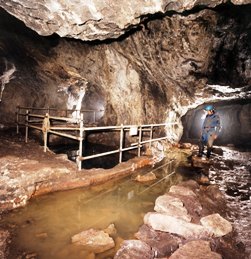
John Barnatt and John Bramley on an old Peak District copper mine, newly reopened to tourists.
Geoscientist 18.1 January 2008
In its heyday in the second half of the 18th Century, the Ecton Copper Mine, overlooking the Manifold Valley near Hulme End, was the deepest and one of the most productive copper mines in the country.
It is claimed that the profits made from the mine in the 1780s by its owner, the Duke of Devonshire, financed the building of the Crescent and Stables, which later became the Royal Hospital and now the University of Derby in Buxton. In our own times, for over 20 years until the foot-and-mouth outbreak of 2001 put a stop to it, the hill and one of the old mine levels were used as an educational resource under the aegis of a mining engineer, the late Mr Geoff Cox (who also owned the mineral rights.) Unfortunately, for the last five years educational groups have not been able to explore the fascinating remains at Ecton. Now, a new charitable company, the Ecton Mine Educational Trust, has been formed to enable educational and local community groups to resume use of study facilities at the historic mines.
The lead mining heritage of the Peak District’s Carboniferous Limestone is well established, but the occurrence of major copper mineralisation in the south-west of the area is less well known. On Ecton Hill the Ecton and Clayton Mines (and many others) exploited unique, rich and almost vertical “pipes” of copper and lead ore as well as associated “veins”. Ecton’s mines were the major UK source of copper in the 1760s-1780s.
Nowadays visiting parties of students are once again taught how to identify a variety of minerals and are taken underground. Thanks to the generosity of Mr Cox’s widow, Elizabeth, the mines and a small study centre on the side of the hill are now owned by the new Trust - whose principal objectives are to promote education and research in applied geology, metalliferous mining, mineral extraction and mining history, and to preserve the mine and its shafts and adits. One of the main activities will be the resumption of day courses for university and school parties. By appointment, other groups interested in industrial archaeology and local heritage will be welcomed, once the Trust has re-established the facilities for receiving them.
The geology and mineralisation of the area are characterised by complex folding and faulting of the limestone and shale strata. Exposures of this, both on surface and underground, represent a valuable study resource. To the non-geologist, greater interest may lie in the social and industrial history of Ecton, which is well documented in the archives at Chatsworth. Many interesting mine features are still visible at surface, many on open-access land or next to public footpaths and roads.
The mineral rights to the Ecton mine were owned by the Dukes (and before that the Earls) of Devonshire from the 17th Century onwards. This area was probably the first to see gunpowder used in a British mine, in the 1660s. In the second half of the 18th Century, the very productive mine reached about 300m below river level, and became the deepest mine in Britain.
Although those deep workings are now flooded, those above river level are still accessible and contain much archaeological interest. They rise for some 100m inside the hill. On the hilltop itself, the engine house stands that once housed one of the first Boulton and Watt steam engines. This and many of the other surface features across the hill have been designated a Scheduled Monument. The mine workings are also a national Site of Special Scientific Interest (SSSI).
Recent research has demonstrated that these ore deposits were worked as long ago as the Bronze Age. The extent of these prehistoric workings has yet to be determined, but Ecton Hill is one of only two known sites in England where hammer stones, the typical artefacts of prehistoric metal mining, have been identified with certainty. The Peak District National Park Authority’s cultural heritage team is hoping to carry out further research into this and other aspects of the mines in the near future.
- If you would like to know more about Ecton in its heyday, the most recent book, The Ecton Copper Mines under the Dukes of Devonshire, 1760 – 1790 by Lindsey Porter (Landmark Publishing) is still available in some Peak District bookshops and is recommended reading. For those wanting to walk around the mining remains, they are included in the walking guide In the Footsteps of Our Ancestors: Heritage Walks, recently published by the National Park Authority BESST project, available in local Tourist Information Centres and bookshops.
- For further information, or to arrange a visit, please go to the Ecton Mine Educational Trust
With kind acknowledgements to Roly Smith, editor, Peakland Guardian, and Friends of the Peak District.